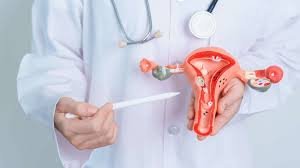Exploring the Interplay Between Polyphenols, Gut Microbiota, and Polycystic Ovary Syndrome (PCOD): A Comprehensive Review

Abstract:
Polycystic
Ovary Syndrome (PCOD) is a common endocrine disorder in women of reproductive
age, marked by hyperandrogenism, insulin resistance, and chronic anovulation.
Emerging research indicates that the gut microbiota significantly contributes
to the pathophysiology of PCOD, affecting both metabolic and hormonal balance.
Polyphenols, bioactive compounds found in various foods, have shown promise in
modulating gut microbiota composition and function, offering potential
therapeutic benefits for PCOD. This review examines the intricate interplay
between polyphenols, gut microbiota, and PCOD, focusing on how polyphenols may
influence PCOD pathogenesis through gut microbiota modulation. We explore the
alterations in gut microbiota observed in PCOD patients and how polyphenols may
help restore microbial balance, potentially improving metabolic and
reproductive health. The review also discusses the underlying molecular
mechanisms, such as the regulation of inflammatory pathways, oxidative stress,
and insulin signaling, through which polyphenols may exert their effects. By
synthesizing findings from preclinical and clinical studies, we highlight the
potential of dietary polyphenols as a complementary strategy in PCOD management,
while also underscoring the need for more research to determine the most
effective dietary interventions and polyphenol formulations. Understanding the
relationship between polyphenols and gut microbiota in the context of PCOD
offers promising new avenues for developing microbiota-targeted therapies that
leverage the beneficial effects of polyphenols to improve outcomes for women
with this condition.
References:
[1].
Singh,
S., Pal, N., Shubham, S., Sarma, D. K., Verma, V., Marotta, F., Kumar, M., 2023,
Polycystic ovary syndrome: Etiology, current management, and future
therapeutics. Journal of Clinical Medicine, 12(4), 1454, https://doi.org/10.3390/jcm12041454
[2].
Tsao,
R., 2010, Chemistry and biochemistry of dietary polyphenols. Nutrients,
2(12), 1231–1246, https://doi.org/10.3390/nu2121231
[3].
Shanmugam,
G., 2024, Polyphenols: Potent protectors against chronic diseases. Natural
Product Research, 1–3, https://doi.org/10.1080/14786419.2024.2386402
[4].
Wu,
H. J., & Wu, E., 2012, The role of gut microbiota in immune homeostasis and
autoimmunity. Gut Microbes, 3(1), 4–14, https://doi.org/10.4161/gmic.19320
[5].
Ray,
S. K., & Mukherjee, S., 2021, Evolving interplay between dietary
polyphenols and gut microbiota—An emerging importance in healthcare. Frontiers
in Nutrition, 8, 634944, https://doi.org/10.3389/fnut.2021.634944
[6]. Kasprzak-Drozd, K.,
Oniszczuk, T., Stasiak, M., & Oniszczuk, A., 2021, Beneficial effects of
phenolic compounds on gut microbiota and metabolic syndrome. International
Journal of Molecular Sciences, 22(7), 3715, https://doi.org/10.3390/ijms22073715
[7]. Rudrapal, M., Khairnar, S. J., Khan, J.,
Dukhyil, A. B., Ansari, M. A., Alomary, M. N., Alshabrmi, F. M., Palai, S.,
Deb, P. K., & Devi, R., 2022, Dietary polyphenols and their role in
oxidative stress-induced human diseases: Insights into protective effects,
antioxidant potentials, and mechanism(s) of action. Frontiers in
Pharmacology, 13, 806470, https://doi.org/10.3389/fphar.2022.806470
[8]. Yan, Z., Zhong, Y.,
Duan, Y., Chen, Q., & Li, F., 2020, Antioxidant mechanism of tea
polyphenols and its impact on health benefits. Animal Nutrition, 6(2),
115–123, https://doi.org/10.1016/j.aninu.2020.01.001
[9]. Chavez, G. N., Jaworsky,
K., & Basu, A., 2023, The effects of plant-derived phytochemical compounds
and phytochemical-rich diets on females with polycystic ovarian syndrome: A
scoping review of clinical trials. International Journal of Environmental
Research and Public Health, 20(15), 6534, https://doi.org/10.3390/ijerph20156534
[10]. Zhou, P., Feng, P., Liao, B., Fu, L., Shan,
H., Cao, C., Luo, R., Peng, T., Liu, F., & Li, R., 2024, Role of
polyphenols in remodeling the host gut microbiota in polycystic ovary syndrome.
Journal of Ovarian Research, 17(1), 69, https://doi.org/10.1186/s13048-024-01354-y
[11]. Shreiner,
A. B., Kao, J. Y., & Young, V. B., 2015, The gut microbiome in health and
in disease. Current Opinion in Gastroenterology, 31(1), 69–75, https://doi.org/10.1097/MOG.0000000000000139
[12]. Thursby,
E., & Juge, N., 2017, Introduction to the human gut microbiota. The
Biochemical Journal, 474(11), 1823–1836, https://doi.org/10.1042/BCJ20160510
[13]. Guo, H.,
Luo, J., & Lin, H., 2023, Exploration of the pathogenesis of polycystic
ovary syndrome based on gut microbiota: A review. Medicine, 102(50),
e36075, https://doi.org/10.1097/MD.0000000000036075
[14]. Li, Y.,
Zhu, Y., Li, D., Liu, W., Zhang, Y., Liu, W., Zhang, C., & Tao, T., 2023,
Depletion of gut microbiota influents glucose metabolism and hyperandrogenism
traits of mice with PCOS induced by letrozole. Frontiers in Endocrinology,
14, 1265152, https://doi.org/10.3389/fendo.2023.1265152
[15]. Wang, X.,
Qi, Y., & Zheng, H., 2022, Dietary polyphenol, gut microbiota, and health
benefits. Antioxidants, 11(6), 1212, https://doi.org/10.3390/antiox11061212
[16]. Cuciniello,
R., Di Meo, F., Filosa, S., Crispi, S., & Bergamo, P., 2023, The
antioxidant effect of dietary bioactives arises from the interplay between the
physiology of the host and the gut microbiota: Involvement of short-chain fatty
acids. Antioxidants, 12(5), 1073, https://doi.org/10.3390/antiox12051073
[17]. Ramamurthy,
J., 2024, Evaluation of antimicrobial activity of nanoformulated grape seed oil
against oral microbes: An in vitro study. World Journal of Dentistry,
15(1), 43–49, https://doi.org/10.5005/jp-journals-10015-2360
[18]. Shabbir,
U., Rubab, M., Daliri, E. B., Chelliah, R., Javed, A., & Oh, D. H., 2021,
Curcumin, quercetin, catechins and metabolic diseases: The role of gut
microbiota. Nutrients, 13(1), 206, https://doi.org/10.3390/nu13010206
[19]. Reygaert,
W. C., 2018, Green tea catechins: Their use in treating and preventing
infectious diseases. BioMed Research International, 2018, 9105261, https://doi.org/10.1155/2018/9105261
[20]. Fan, F. Y.,
Sang, L. X., & Jiang, M., 2017, Catechins and their therapeutic benefits to
inflammatory bowel disease. Molecules, 22(3), 484, https://doi.org/10.3390/molecules22030484
[21]. Sun, Y.,
Gao, S., Ye, C., & Zhao, W., 2023, Gut microbiota dysbiosis in polycystic
ovary syndrome: Mechanisms of progression and clinical applications. Frontiers
in Cellular and Infection Microbiology, 13, 1142041, https://doi.org/10.3389/fcimb.2023.1142041
[22]. Hamamah,
S., Iatcu, O. C., & Covasa, M., 2024, Nutrition at the intersection between
gut microbiota eubiosis and effective management of type 2 diabetes. Nutrients,
16(2), 269, https://doi.org/10.3390/nu16020269
[23]. Zhang, Y.,
Yu, W., Zhang, L., Wang, M., & Chang, W., 2022, The interaction of
polyphenols and the gut microbiota in neurodegenerative diseases. Nutrients,
14(24), 5373, https://doi.org/10.3390/nu14245373
[24]. Abdelsalam,
S. A., Renu, K., Zahra, H. A., Abdallah, B. M., Ali, E. M., Veeraraghavan, V.
P., Sivalingam, K., Ronsard, L., Ammar, R. B., Vidya, D. S., Karuppaiya, P.,
Al-Ramadan, S. Y., & Rajendran, P., 2023, Polyphenols mediate
neuroprotection in cerebral ischemic stroke—An update. Nutrients, 15(5),
1107, https://doi.org/10.3390/nu15051107
[25]. Kumar, N., & Goel, N., 2019, Phenolic
acids: Natural versatile molecules with promising therapeutic applications. Biotechnology
Reports, 24, e00370, https://doi.org/10.1016/j.btre.2019.e00370
[26]. Anantharaju,
P. G., Gowda, P. C., Vimalambike, M. G., & Madhunapantula, S. V., 2016, An
overview on the role of dietary phenolics for the treatment of cancers. Nutrition
Journal, 15(1), 99, https://doi.org/10.1186/s12937-016-0217-2
[27]. He, F. F.,
& Li, Y. M., 2020, Role of gut microbiota in the development of insulin
resistance and the mechanism underlying polycystic ovary syndrome: A review. Journal
of Ovarian Research, 13(1), 73, https://doi.org/10.1186/s13048-020-00670-3
[28]. Williamson,
G., & Sheedy, K., 2020, Effects of polyphenols on insulin resistance. Nutrients,
12(10), 3135, https://doi.org/10.3390/nu12103135
[29]. Zhou, M.,
Yu, J., Li, X., Ruan, Z., & Yu, S., 2024, Role of the gut microbiota and
innate immunity in polycystic ovary syndrome: Current updates and future
prospects. Journal of Cellular and Molecular Medicine, 28(8), e18258, https://doi.org/10.1111/jcmm.18258
[30]. Bharali, M.
D., Rajendran, R., Goswami, J., Singal, K., & Rajendran, V., 2022,
Prevalence of polycystic ovarian syndrome in India: A systematic review and
meta-analysis. Cureus, 14(12), e32351, https://doi.org/10.7759/cureus.32351
[31]. Islam, M.
T., Mazumder, S., Aniqa, F. T., Uddin, N., Rahman, M. A., Sarkar, C., Mondal,
M., Mubarak, M. S., & Rengasamy, K. R. R., 2024, Investigating the
hepatoprotective properties of thymol against paracetamol-induced
hepatotoxicity. Food Bioscience, 60, 104498, https://doi.org/10.1016/j.fbio.2023.104498
[32]. Azizi, A.,
Mumin, N. H., & Shafqat, N., 2021, Phytochemicals with anti
5-alpha-reductase activity: A prospective for prostate cancer treatment. F1000
Research, 10, 221, https://doi.org/10.12688/f1000research.51066.3
[33]. Sinan, K.
I., Sut, S., Zengin, G., Dall'Acqua, S., Bouyahya, A., Uba, A. I., Ponniya, S.
K. M., & Rengasamy, K. R. R., 2024, Integration of chemical
characterization, biological activities, and network pharmacology of different
extracts from Syzygium rowlandii. Journal of Molecular Structure, 1299,
137117, https://doi.org/10.1016/j.molstruc.2023.137117
[34]. Liu, J., Liu, Y., & Li, X., 2023, Effects
of intestinal flora on polycystic ovary syndrome. Frontiers in
Endocrinology, 14, 1151723, https://doi.org/10.3389/fendo.2023.1151723

